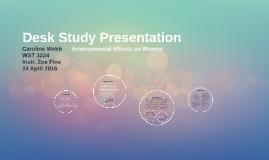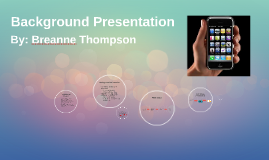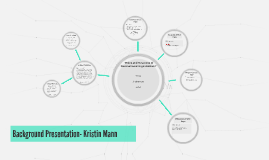Desk Study Presentation
Transcript: Not just women. Not just men. Everyone. Examples: "health, politics, and society can intermingle to either strengthen women or fail them". Some articles addressed the physical aspect and how physical effects not only have an impact on today's women, but on future generation. Hypothesis “Justice for All? Factors Affecting Perceptions of Environmental and Ecological Injustice, "Impact Of Air Pollution On Women's Health.” From "Confronting WHITENESS FLINT WATER CRISIS.” by Crecory Shafer: From Huang, Chih-Tung1, "Shaping Environmental Justice: Applying Science, Technology And Society Boundary Work." Other Studies that focused on similar environmental characteristics: “I suggest that the Environmental Justice movement is still dependent on scientists to provide a scientific way to foster equal distribution of environmental risks. However, to achieve a just distribution, science along is not enough. Public participation in the field of both EJ science and the political movement is necessary.” However, these are not the only environments that prove to be toxic for women. Bryant, Kathy. "Impact Of Air Pollution On Women's Health." Otolaryngology - Head And Neck Surgery 2 (1996): 267. Academic OneFile. Web. 7 Feb. 2016 Buckingham and Kulcur’s analysis takes the political route to expose and explain gender blindness and why it can be detrimental to women’s health when seen in government organizations. Hypothesis Bryant, Kathy. "Impact Of Air Pollution On Women's Health." Otolaryngology - Head And Neck Surgery 2 (1996): 267. Academic OneFile. Web. 7 Feb. 2016 Buckingham, Susan, and Rakibe Kulcur. "Gendered Geographies Of Environmental Injustice." Antipode 41.4 (2009): 659-683. Academic Search Premier. Web. 6 Mar. 2016. Chan, Lisa M., Stephanie M. Chalupka, and Roseann Barrett. "Female College Student Awareness Of Exposures To Environmental Toxins In Personal Care Products And Their Effect On Preconception Health." Workplace Health & Safety 63.2 (2015): 64. Publisher Provided Full Text Searching File. Web. 7 Feb. 2016. Chircop, Andrea. "An Ecofeminist Conceptual Framework To Explore Gendered Environmental Health Inequities In Urban Settings And To Inform Healthy Public Policy." Nursing Inquiry 15.2 (2008): 135-147. Academic Search Premier. Web. 7 Feb. 2016. From: “An Ecofeminist Conceptual Framework To Explore Gendered Environmental Health Inequities In Urban Settings And To Inform Healthy Public Policy”: Different Forms of "Environment" Works Cited Umukoro, Nathaniel. "Toxic Communities: Environmental Racism, Industrial Pollution, And Residential Mobility." Ethnic And Racial Studies 13 (2015): 2479. Academic OneFile. Web. 6 Mar. 2016. My desk study focuses on women's health as it relates to the environment. Based on my research, the blanket statement solution would be policy change. What I have found throughout my research is that the hypothesis proved to be true, and women's health and the environment have a very definite and clear link. This includes physical as well as mental effects and social characteristics that can enhance them. Why are these solutions important? Solutions such as policy change also benefit greatly from social media encouragement and private funding. Another route that always promotes change is discussion, which all of these studies include. Reaching unengaged stakeholders is a key component of bringing about change. “The discussion is not meant to reflect an essentialist position, rather it is emphasized that there are shared historical, social and political connections of women as a social group in Western societies.” By changing policy, we can regulate how these toxins are reaching people. Through policy change, events like Flint, Michigan water crisis can be avoided. Women, man, and children in low-income areas will be less likely to encounter toxins. "International Federation Of Gynecology And Obstetrics Opinion On Reproductive Health Impacts Of Exposure To Toxic Environmental Chemicals." International Journal Of Gynecology And Obstetrics 3 (2015): 219. Academic OneFile. Web. 7 Feb. 2016. the urban environment is the “natural environment for the majority of North American populations” (Canadian Institute of Health Information (CIHI) 2006; Hancock 2002). Woodruff, Tracey J., and Linda C. Giudice. "Environmental Impacts on Reproductive Health and Fertility." Environmental Impacts on Reproductive Health and Fertility (2010): 1-240. USF Library. Web. 07 Feb. 2016. In short, this is everyone's issue. Scholars in my study say that factors such as age, socioeconomic status, health, and politics can effect women uniquely. In my study, when I say women's health as it relates tot he environment, I mean both the physical and societal environments around women. Study Designs Used: Why are these solutions important? SHAFER, CRECORY. "Confronting WHITENESS FLINT WATER CRISIS." Humanist 76.2 (2016): 22-26. Academic Search Premier. Web. 6 Mar. 2016. Caroline Webb WST 3224 Instr. Zoe Fine 24 April 2016

















